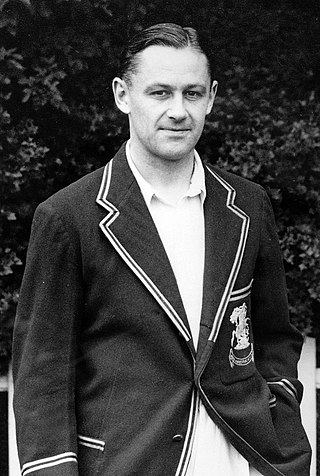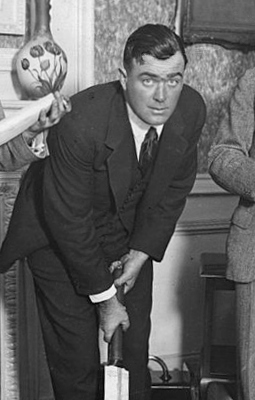Related Research Articles

Sir Leonard Hutton was an English cricketer. He played as an opening batsman for Yorkshire County Cricket Club from 1934 to 1955 and for England in 79 Test matches between 1937 and 1955. Wisden Cricketers' Almanack described him as "one of the greatest batsmen in the history of cricket". He set a record in 1938 for the highest individual innings in a Test match in only his sixth Test appearance, scoring 364 runs against Australia, a milestone that stood for nearly 20 years. Following the Second World War, he was the mainstay of England's batting. In 1952, he became the first professional cricketer of the 20th century to captain England in Tests; under his captaincy England won the Ashes the following year for the first time in 19 years.

Arthur Edward Robert Gilligan was an English first-class cricketer who captained the England cricket team nine times in 1924 and 1925, winning four Test matches, losing four and drawing one. In first-class cricket, he played as an amateur, mainly for Cambridge University and Sussex, and captained the latter team between 1922 and 1929. A fast bowler and hard-hitting lower order batsman, Gilligan completed the double in 1923 and was one of Wisden's Cricketers of the Year for 1924. When his playing career ended, he held several important positions in cricket, including that of England selector and president of the Marylebone Cricket Club (MCC). A popular figure within cricket, he was widely regarded as sporting and friendly.
Greville Thomas Scott Stevens was an English amateur cricketer who played for Middlesex, the University of Oxford and England. A leg-spin and googly bowler and attacking batsman, he captained England in one Test match, in South Africa in 1927. He was widely regarded as one of the leading amateur cricketers of his generation who, because of his commitments outside cricket, was unable to fulfil his potential and left the game early.

Arthur Percy Frank Chapman was an English cricketer who captained the England cricket team between 1926 and 1931. A left-handed batsman, he played 26 Test matches for England, captaining the side in 17 of those games. Chapman was appointed captain for the final, decisive Test of the 1926 series against Australia; under his captaincy, England defeated Australia to win the Ashes for the first time since 1912. An amateur cricketer, Chapman played Minor Counties cricket for Berkshire and first-class cricket for Cambridge University and Kent. Never a reliable batsman, Chapman nevertheless had a respectable batting record. He could score runs very quickly and was popular with spectators. As a fielder, contemporaries rated him extremely highly. Although opinions were divided on his tactical ability as a captain, most critics accepted he was an inspirational leader.

Frederick Somerset Gough Calthorpe, styled The Honourable from 1912, was an English first-class cricketer.

Sir George Oswald Browning "Gubby" Allen CBE was a cricketer who captained England in eleven Test matches. In first-class matches, he played for Middlesex and Cambridge University. A fast bowler and hard-hitting lower-order batsman, Allen later became an influential cricket administrator who held key positions in the Marylebone Cricket Club (MCC), which effectively ruled English cricket at the time; he also served as chairman of the England selectors.

Thomas Coleman Lowry was a New Zealand international cricketer. He was New Zealand's first Test captain, and led the team in their first seven Test matches between January 1930 and August 1931. He played first-class cricket from 1918 to 1937. He was a farmer and racehorse breeder in Hawke's Bay, who served as president of the New Zealand Thoroughbred Breeders Association from 1951 to 1965.
Colonel John Cabourn Hartley, known as Jock Hartley, was an English first-class cricketer and British Army officer.
An England team toured Australia between November 1920 and March 1921. The tour was organised by the Marylebone Cricket Club and matches outside the Tests were played under the MCC name. The tour itinerary consisted of 13 first-class matches, including a series of 5 Test matches against Australia in which The Ashes were at stake.
The New Zealand cricket team toured England in the 1927 season. The team contained many of the players who would later play Test cricket for New Zealand, but the tour did not include any Test matches and the 1927 English cricket season was the last, apart from the Second World War years and the cancelled South African tour of 1970, in which there was no Test cricket in England.
The New Zealand cricket team toured England in the 1931 season. The tour was the first tour by a New Zealand team in which Test matches were arranged. Originally, only one Test was planned, but New Zealand acquitted themselves so well in the first match and in the game against MCC that matches against Surrey and Lancashire were hastily replaced by two further Test matches. Of the three Tests played, the first was drawn, the second was won comfortably by England; the third was heavily affected by rain and also drawn. The tour as a whole was blighted by poor weather, and 23 of the 32 first-class matches ended as draws.
The West Indian cricket team that toured England in the 1928 season was the first to play Test cricket. The team was not very successful, losing all three Tests by an innings and winning only five of the 30 first-class matches played.
The England national cricket team toured the West Indies from January to April 1930 and played a four-match Test series against the West Indies cricket team which was drawn 1–1. England were captained by Freddie Calthorpe; West Indies by a different captain at each venue. They were the first Tests played in the West Indies.
This article describes the history of Australian cricket from the 1918–19 season until 1930.
This article describes the history of New Zealand cricket from the 1918–19 season until 1945.
The England cricket team toured Australia in 1928–29. England, known as the MCC in matches outside the Tests, retained The Ashes, winning the first four Tests and losing the last for a 4–1 series victory.
The England national cricket team toured Ceylon, Australia and New Zealand in the 1929–30 season to play a Test series against the New Zealand national cricket team. This was the first Test series ever played by New Zealand. England began the tour in October 1929 in Ceylon with a single minor match and then in Australia where they played five first-class matches. The New Zealand leg of the tour began in December and, in addition to the Test series, England played each of the main provincial teams: Auckland, Wellington, Canterbury and Otago. England, captained by Harold Gilligan, won the Test series 1–0 with three matches drawn.
An English team raised by Marylebone Cricket Club (MCC) toured New Zealand from December 1922 to February 1923 and played eight first-class matches including three against the New Zealand national cricket team. MCC also played the main provincial teams including Auckland (twice), Wellington, Canterbury and Otago. The overall tour included a short stopover in Ceylon, where a single minor match was played, and two visits to Australia where a total of seven first-class matches were played.
Charles Harold Titchmarsh was an English cricketer active in first-class cricket from 1920 to 1928, but was mostly associated with minor counties cricket where he played for Hertfordshire.
References
- ↑ "English Team's Visit: Some Personal Details". Nelson Evening Mail. Vol. LVI. 7 October 1922. p. 7.
- ↑ "English team on the way". Evening Post. Vol. CIV, no. 91. 14 October 1922. p. 15.
- ↑ "The M.C.C. Team in Australia and New Zealand", The Cricketer , 12 May 1923, pp. 16-17.
- ↑ "First-class batting and fielding in Australia for 1922-23". CricketArchive. Retrieved 26 February 2017.
- ↑ "First-class bowling in Australia for 1922-23". CricketArchive. Retrieved 26 February 2017.